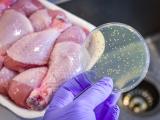Feb 1, 2005 (CIDRAP News) Bovine spongiform encephalopathy (BSE), or mad cow disease, has been confirmed in a goat for the first time, but the finding poses little risk to consumers, European Commission (EC) officials announced Jan 28.
The goat was slaughtered in France in 2002, and it took more than 2 years of testing to determine that the disease was BSE rather than scrapie, a closely related disease in sheep and goats. Both BSE and scrapie are among the brain-wasting diseases known as transmissible spongiform encephalopathies (TSEs).
The case may mark the first discovery of BSE under natural conditions in animals other than cattle. Will Hueston, DVM, director of the University of Minnesota Center for Animal Health and Food Safety, said the disease has been seen in some other ruminant animals in zoos, including American buffalo and African antelope. BSE has been induced experimentally in sheep, he said.
The EC stated, "Although this is the first time that BSE has been found in a goat under natural conditions, precautionary measures to protect consumers from this eventuality have been applied in the EU [European Union] for several years. The level of TSE infection in goats seems however to be extremely low and any possible risk to consumers is minimal."
BSE, first detected in 1986, spread through British cattle herds in the 1980s and 1990s after the cattle ate feed containing protein from TSE-infected animals. The disease also made its way into cattle in a number of other countries; one case has been found in the United States and three in Canada. Eating meat products from BSE-infected cattle is the assumed cause of variant Creutzfeldt-Jakob disease (vCJD), the human equivalent of BSE. The EC said 165 confirmed or suspected cases of vCJD, mostly in the United Kingdom, had been reported by member countries as of Jan 1.
The goat was originally tested under the European Union's regular TSE surveillance program, in which more than 140,000 goats have been tested since April 2002, officials said. French researchers first announced the finding of BSE last October. The French sent their data to the EC's TSE reference laboratory in England for evaluation by an expert panel, which confirmed the finding Jan 28.
The goat and its herd in southeastern France were kept out of the human food and animal feed chains, the EC statement said. After the French announcement of the case last fall, the European Food Safety Authority (EFSA) said milk and milk products from clinically healthy goats were unlikely to pose any risk of TSE contamination. But in an animal with mastitis, potentially infected blood might filter into the milk, the statement said.
The EC and EFSA said there is no evidence of a link between goat meat consumption and an increased risk of vCJD but that such a link can't be completely ruled out.
Existing rules ban the use of milk and meat from TSE-infected goats (though scrapie is not believed to be transmissible to humans), the EC said. As is true for cattle and sheep, "specified risk materials (the tissues most likely to carry infectivity if the disease is present) are also removed from all goats even if no infection is detected," the statement said. "While it is not possible to say that there is absolutely no risk, any potential risk will be mitigated by the safety measures put in place."
The EC said it is not recommending any restrictions on consumption of goat milk, cheese, and meat. But it has asked the EFSA to conduct a risk assessment on goat meat and present the results by July of this year.
The EFSA, in a Jan 28 statement, said very little information on the topic is available and that the risk assessment will have to depend on unpublished data supplied by European Union members and other countries.
Meanwhile, the EC said it will increase BSE testing of goats for at least 6 months in an effort to find out if the case is an isolated one. Officials hope to test 200,000 healthy goats, focusing mainly on states where BSE is present in cattle.
The EC statement suggested that contaminated feed was the most likely cause of BSE in the goat, even though the commission banned the feeding of mammalian meat-and-bone meal to ruminant animals in 1994. "The feeding of meat-and-bone meal (MBM) to ruminants is generally considered to be the transmission route of BSE," the statement said. Noting that the goat was born in 2000, it continued, "In January 2001 the existing ban on feeding MBM to all ruminants was extended to a total ban on feeding MBM to all farmed animals."
Hueston suggested that the finding didn't come as a complete surprise to BSE researchers. "There's been an ongoing discussion in the past 5 years or so as to whether BSE might have spread in sheep and goats through feed," he said. "This meat-and-bone meal was used in sheep and goat feeds as well as cattle feeds."
It took extensive and prolonged testing to determine that the goat's disease was BSE and not scrapie, Hueston said. Both diseases involve progressive brain degeneration and the accumulation of abnormal proteins in the brain. But analyses of the goat's brain showed that the protein was "indistinguishable from BSE protein and very different from scrapie proteins," he said.
Three stages of tests were done on the goat, according to the EC. The last stage was a mouse bioassay, in which material from the goat was inoculated into mice to see if it would trigger a similar disease in them. European investigators have conducted mouse bioassays on five other goats, of which two have been negative and three are incomplete but are expected to be negative, officials said.
See also:
Jan 28 EC news release
http://europa.eu/rapid/pressReleasesAction.do?reference=IP/05/105&format=HTML&aged=1&language=EN&guiLanguage=en
EC questions and answers on TSE in goats
http://europa.eu/rapid/pressReleasesAction.do?reference=MEMO/05/29&format=HTML&aged=0&language=EN&guiLanguage=en
Jan 28 EFSA statement on safety of goat meat
http://ec.europa.eu/food/food/biosafety/bse/crl_statement_tse_goats_28-01-05_en.pdf


















